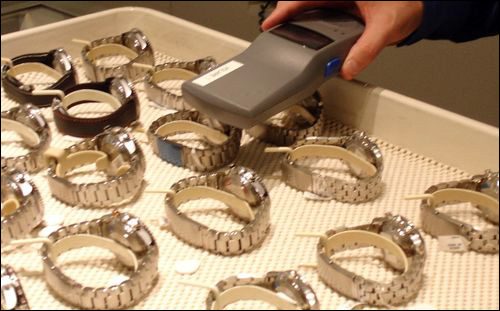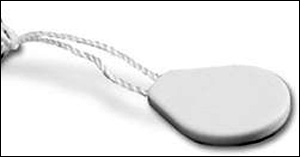To track inventory levels, most jewelry stores conduct a daily count of goods that are moved into and out of vaults during off-hours, with larger cycle counts of an entire store conducted less frequently. But for a jewelry store the size of Borsheims—a 62,000-square-foot site that carries 88,000 pieces of fine jewelry and other goods ranging up to $1 million in price—tracking expensive items is time-consuming but nonetheless critical, says Erin Limas, the store’s chief financial officer.
The company is employing the ZeroShrink RFID solution from TJS. ZeroShrink, Limas reports, has already paid for itself since its installation in 2012, by reducing the amount of time required for inventory counts, as well as eliminating shrinkage and providing better control over store inventory.

Borsheims, owned by Berkshire Hathaway, is the anchor store at an Omaha shopping mall, where it sells fine china, stemware and silver, along with fine jewelry and watches. Approximately 10 years ago, Limas recalls, the company had considered an RFID solution for tracking its available merchandise, but decided the technology’s demonstration was not very impressive, as it required that jewelry be moved around in order to be read. What’s more, she adds, the cost of RFID tags was high.
Last year, however, the company was impressed with the ZeroShrink system, Lima says, and chose to test TJS’ Cotton Thread tag on its high-value watches. The reusable high-frequency (HF) 13.56 MHz tag, measuring 16 millimeters (0.63 inch) in diameter, is integrated with a cotton thread that loops around a piece of jewelry, and complies with the ISO 15693 standard. Borsheims attached a Cotton Thread tag to each watchband, says Adrian Prezioso, TJS’ chief technology officer. Borsheims’ staff carried a handheld reader for interrogating the tags at the point of sale (POS), as well as during daily inventory counts. Every morning, as a tray of watches was removed from the vault, the sales staff waved the TJS reader (TJS reports that it works with several RFID tag and reader vendors that it declines to name) over the tray, thereby capturing each item’s unique ID number. The ZeroShrink software, which resides as a standalone system at Borsheims’ site, records the ID linked to each item’s stock-keeping unit (SKU) data. At the end of the day, employees connect the reader to the PC running the ZeroShrink software and upload the collected data.
The staff can also read tags located within a display case, by opening the cabinet and waving the reader above the items stored within.
During the pilot, as a watch was sold, the staff utilized another RFID reader connected to a PC to “decommission” that watch’s tag, which amounted to reading the tag to remove its ID number from the store’s inventory list, thereby indicating it was purchased. At day’s end, management reviewed the details of the transaction and could determine any discrepancies denoting that an item was missing but had not been decommissioned (sold to a customer). Management could then conduct any necessary follow-up investigations.
With the technology in place, the store found that staff members could read the more-than 400 watch tags daily in less than 15 minutes. That same process, the company reports, previously took more than 30 minutes to complete without RFID.
Once management determined that the technology worked well, the retailer began applying tags to other items as well. Previously, Borsheims had chosen to test RFID on watches because the tags could be more discretely placed within a watchband to ensure that it did not interfere with the aesthetics of items being sold. For necklaces, bracelets, rings and other delicate items, however, the retailer chose to use TJS’ Label tag, which measures 18 millimeters by 14 millimeters (0.71 inch by 0.55 inch) and can be affixed to an item, and then be discarded once that merchandise is sold. Workers need to be careful not to break the tag, Limas says, as folding or bending the tag can cause it to cease functioning. She says the staff has thus learned to tuck the tags into notches on the molds displaying the jewelry, for example, in such a way that they are not damaged. Limas expects the store to tag as many as 5,000 or more items, but notes that lower-value goods will not be tagged.
The store’s next step will be to integrate the ZeroShrink software with Borsheims’ POS software, provided by Applications Systems Corp. (ASC). Staff members currently must read a tag and then use the POS software to complete a sales transaction, thus necessitating two separate steps. In the future, however, sales data would be automatically extracted by the ZeroShrink software, thereby updating inventory status as each tagged item is sold.
In addition, Borsheims has been testing a mobile battery-powered RFID reader built into a display tray that staff members present to customers when they wish to try on a piece of jewelry. This reader provides the store with data indicating the number of times that a specific product is viewed, as well as which sales associate provided that item. First, the worker takes the piece of jewelry out of the cabinet and places it on a velvet- or leather-covered tray. The reader built into the tray captures the item’s tag ID as the staff member presents the tray to the customer to try on or examine more closely. Each sales associate would have a unique tray to connect her or him with the event.
Once the workday ends, the tray reader is plugged into a PC via a USB connection, in order to load the read data in the ZeroShrink software so that it can be reviewed by management.
TJS, now headquartered in Boston, developed the RFID-based solution about seven years ago, initially providing it for a Dubai bank interested in tracking the use of its gold by its jewelry retailer clients (see RFID Tracks Jewelry Sales, Inventory in Mideast), before bringing the technology to the United States. At present, the company has 140 RFID-based deployments at jewelry stores across 17 countries, says Johnny Hazboun, the company’s CEO.


